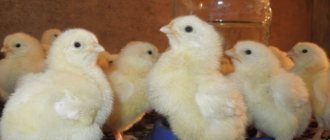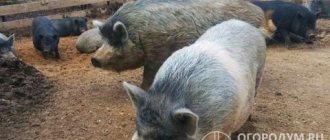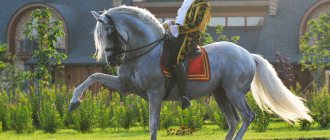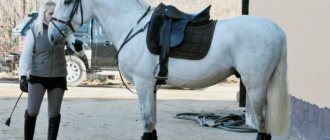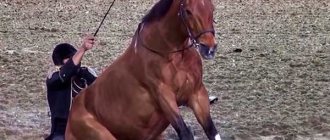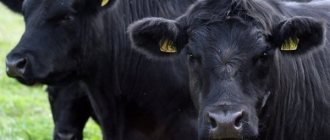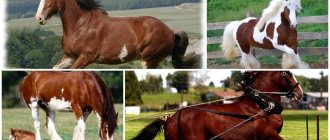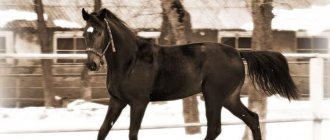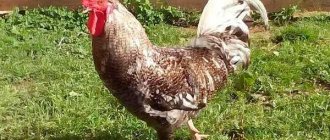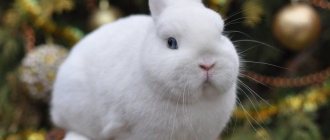A horse is an animal that man has tamed for a long time in order to make his life easier. Experts say that humans domesticated this animal more than 6,000 years ago.
For many centuries, the horse has regularly served people in various types of activities: on the farm, in the military industry, and also as transport. The image of a horse has found its application in art. Some species can only be seen in ancient paintings.
Over the centuries, people have bred new breeds of horses that perform strictly defined tasks. Characteristics began to be grouped not only according to climate, but also according to physiological data.
The development of technological progress has caused many species of horses to disappear . But caring livestock breeders try to prevent such phenomena and work on breeding horse breeds.
Heavy draft horses are considered the largest horses in the world. These include the Shire (English heavy truck). Representatives of the breed reach two meters at the withers. These can be fat horses or hardy heavy draft horses. However, this is not always the fattest horse , but often the heaviest. The Shire is considered the largest horse breed.
Description of the Shire horse
The Shire breed is a heavy-duty breed. She traces her ancestry back to medieval England, where such horses were used not only for transporting heavy loads, but also for military purposes, because knights in armor weighed a lot, and not every animal could withstand such a load for a long time.
To develop a new breed, Flemish and Friesian horses were crossed with local ones. For several hundred years, breeders have been achieving their goals, and the result exceeded all expectations.
At the moment, the standard implies three different colors: bay, black and gray. Small white spots and white stockings on the legs are acceptable. The main difference between Shire horses is their size - the stallion’s height is from 173 cm, weight from 900 kg, chest from 215 cm in diameter, pastern from 25 cm in diameter.
These are minimum values and on average horses exceed them. The build is proportional, the chest, back, and sacrum are wide. The largest registered stallion is Samson (Mammoth), with a height at the withers of 2.19 meters and a weight of 1520 kg.
You can especially notice the difference with ordinary horses when a person is standing next to you. You can see in the photo of the Shire that these horses are much larger than the animals we are used to.
The part of the leg called the metacarpus has a specific meaning and indicates the structure of the tendons and ligaments. This part of the leg is different for different breeds; heavy draft horses have a rounded metacarpus. The friezes (hair on the lower legs) of this breed are thick and long.
The head is large, with a wide forehead, small ears, and a short neck. There is a hump on the nose. The body is muscular, the legs are strong, powerful, the hooves are large. The tail is set high. The mane is fluffy and long. Its natural beauty is decorated by the owners themselves by weaving various braids, as well as by weaving bright ribbons into the mane.
Within the breed, there are also slight differences between horses in appearance, depending on where they come from. So their Yorkshire horses are leaner and hardier. Cambridges are more boned and the friezes on their legs are longer.
Habitat and characteristics of the Shire breed
As mentioned earlier, the Shire breed was developed in England, and later from there it began to spread first to Ireland and Scotland, and then throughout the world. The 16th century needed heavy horses that took part in military campaigns. Later, knights rode horses in tournaments.
In the 18th century, the roads were improved, and heavy stagecoaches began to run along them, which could only be pulled by large shires. The popularity of this breed has increased even more. In the 19th century, agriculture began to actively develop, and the hardy and obedient giants became the main labor force.
At the beginning of the 20th century, the breed was widely represented in the United States. But, after the end of the Second World War, the need for large horses gradually disappeared.
People began to travel by other means of transport, and maintaining such a large horse was costly, so farmers preferred to abandon this breed in favor of smaller horses.
If in 1909-1911. Since more than 6,600 individuals were registered in the United States, by 1959 only 25 representatives of the breed remained! The Shires gradually died out.
Now the breed is again gaining popularity in all countries. This is largely thanks to the conservative English, for whom shires are not just strong, useful and practical animals, but part of history. The Shire Breed Society presented an annual prize to the best horse of this breed.
The amount was quite impressive - 35 thousand pounds sterling. The revival of the population was also helped by the growth of the sales market abroad. Horses now play a largely aesthetic role. Numerous exhibitions, performances, tournaments, shows and auctions are held.
Historical data
The first reports of strong, powerful horses date back to the 11th century. To breed a generation of hardy horses, local representatives were crossed with Friesians and Flanders. The Belgian draft horse played a significant role in the appearance of the Shire.
We also recommend reading:
Zebra: white with black stripes, or black with white stripes? Horse anatomy: skeletal structure, number of bones, skull Horse running: performance features and types of gaits What horses prefer and like to eat
The authorities issued decrees not allowing the breeding of breeds with a height of less than 154 cm. To increase height, they recommended crossing Shires with other large equestrian representatives. For example, with the Belgian ones. However, Belgian breeds are slightly inferior to Shires in height and weight.
Queen Elizabeth was also interested in increasing the number of draft horses in the 16th century. Strict control was carried out over the optimal parameters of the breed.
In 1878, information appeared about the founder of the breed, nicknamed the Blind Horse. Whether the animal was truly blind is no longer known today. At the same time, a Shire breeding society was formed, breed parameters were developed, and the Shire began to participate in exhibitions.
The name "shire" did not appear immediately . At first the breed was called the “great horse”. Then the horses were called Old English. In the 18th century, the name “shire” was established.
Care and price of a Shire horse
Keeping a Shire is not fundamentally different from keeping other horses. But you need to know that furry legs need to be kept dry, that is, monitor the condition of the litter.
Otherwise, the Shire may develop woodlice on his legs. This is an unpleasant disease that is easier to prevent. After a walk, you need to wash your legs and hooves, sprinkle them with sawdust and comb them later.
The mane and bushy tail do not require special care; you just need to comb them and clean them of dirt. In hot weather, you can braid your mane to prevent your hair from getting tangled. In the summer, you need to wash your horse twice a week with shampoo and conditioner.
You can buy an English heavy draft Shire but you need to be prepared for the fact that the price for an adult horse is quite high, reaching up to 1.5 million rubles. You can buy a foal for a price starting from 300 thousand.
Shire horse nutrition
Each owner chooses for himself what to feed his pets. All horses can be kept on concentrated feed, but hay and grass are required. Due to their large size, Shires eat much more.
Heavy trucks eat 12-15 kilograms of hay or grass per day. But they don’t need concentrates, and it doesn’t cost much to give them. No fertilizing is needed for growth.
It is best to include herbal flour and cake in the diet as nutritional supplements. In summer, such food can be given from 5 to 7 kilograms. Your pet will also be happy with vegetables and fruits - beets and carrots, apples. The animal should always have clean water to drink.
Reviews
According to horse breeders, the advantages of Shire horses include the following qualities:
- Endurance, ability to carry heavy loads;
- Horses are hard workers;
- Calm character, kindness;
- low operating costs;
- easy to feed.
- They quickly and easily learn various commands;
Shire horses have only one drawback - they eat a lot (in one day they eat 1.5-2 times more feed than horses of other breeds), although some do not call this a drawback.
Reproduction and life expectancy of the breed
When breeding a breed, not only the appearance of the Shire horse matters, but the mare is also selected according to its standard. It must be proportional, the same as the male, only smaller in all respects.
The breed's stud book was closed for some time, but now it has been reopened and built on a different principle. The offspring are treated very strictly; in order to be sure of the eminence of this or that foal, a DNA test is done on it.
All animals are entered into a stud book, but in different sections. Newborn females from a purebred sire and an unregistered mare are classified as “A”.
This filly is covered by a purebred stallion, their offspring already belong to category “B”. If the offspring is again female, then she is again covered by a registered stallion and their offspring are considered purebred. On average, horses live 20-35 years, but much depends on the conditions of keeping and care.
Shire horse
Shire horses are of English origin. They have been highly valued at all times due to their strength. Even today, in the age of the heyday of technological progress, these beautiful and stately horses are popular. This breed is considered the largest in the world and has influenced many other lines. On its basis, the Vladimir heavy truck of domestic selection was developed.
Interesting Facts
The Shire has enormous gravity. It was used for agricultural work, to tow barges in the days when the canal system was the main means of transporting goods, and as a vehicle for road transport.
One traditional use was to pull brewing wagons delivering beer, and some are still in use today; others are used for forestry, riding and advertising.
History of the breed
There is no reliable information about the origin of the Shire breed. It is believed that they were bred from local English working mares by crossing with stallions from Holland during the reign of Henry VIII. The name "shire" comes from the English word "shire", which translates as "county".
It is believed that the ancestors of Shire horses repeatedly participated in battles and were extremely strong and tireless. In peacetime, these animals were used in agriculture. They were harnessed to carriages and loaded carts and to plows. The Shires easily delivered building materials and goods from one point to another, moving along broken roads.
Attention! The first representative of the breed whose name is recorded in the Shire stud book is a stallion from Packington named Blind. It is now impossible to confirm whether the horse was sighted or not.
In the 18th century, the blood of Friesian horses was added to the breed. This entailed changes in the appearance of heavy trucks: they became more mobile and faster, but did not lose power and retained the same body dimensions. During that period, the breed began to gain popularity in Europe. It was called the English crow because the predominant coat color of the animals was black.
In the 19th century, it became fashionable to ride in carriages, and strong, stately and agile shires were the best suited for riding in a harness. With the development of agriculture, an even greater need for draft power arose. Now horses were used in wood processing plants and sawmills, in road construction and other industries where their help was needed.
Crisis and revival
The First and Second World Wars nearly deprived England of its Shire population. A significant part of the tribe was lost during this difficult time in battles. Then came the era of mechanization, so that horse power was replaced by machines.
Shire foal
In the 60s of the 20th century, the population did not exceed 100 animals, but thanks to dedicated people it was possible to preserve and restore it. Shires were used as improvers of other breeds, so they were in demand abroad.
Originality of character
Shires are distinguished by their kindness and balanced, calm disposition. They are peaceful, obedient and flexible. They are characterized by loyalty, lack of nervousness and fearlessness. These qualities made horses indispensable for medieval battles and tournaments. After all, a war horse should not be afraid of the roar of weapons, the screams of angry warriors and the swings of blades.
English strongmen obediently drag loaded carts and plows. They fulfill any demands of their owners - they have a lot of patience. To control such a horse, strength is required. Shire is difficult to accelerate into a gallop; the best gait option for him is a gait.
It is difficult to accelerate shires into a gallop; gait is preferable.
Description and characteristics
Back in the 16th century, the English government prohibited the breeding of horses whose height was below 1.54 m. This order was strictly followed, which led to an increase in the size of the breed. Today the shires are considered the largest in the world. The average height of a stallion that has reached the age of three is 1.8 m, and such handsome horses weigh 900–1200 kg.
Attention! The famous horse named Samson holds the record for height. He was born in 1846. Its height at the withers was 2 m 19 cm. Later, the horse was given a different name - Mammoth.
- massive broad-browed head;
- wide-set eyes with an expressive gaze;
- small pointed ears;
- Roman profile;
- relatively short, but very massive curved neck;
- strong muscular forearms;
- short powerful back with a slight arch;
- elongated wide croup with a high-set tail;
- powerful short limbs with lush friezes below and large strong hooves;
- Common colors of shires are bay in different variations, karak, black, and gray.
Appearance
The horse's straight and short neck should flow smoothly into a short and strong back. The rear part of the body of the Shire horse breed should be powerful and large, and the tail should be set high. The horse's strong and powerful fore and hind limbs, with large and strong hooves, are connected by muscular forearms.
Shire draft horses are officially recognized as the strongest, largest and heaviest horses.
Shires in harness
Usage
In the 18th and 19th centuries, Shire horses were used in agriculture. They helped plow and transport building materials. Today these animals are of historical value for England. They participate in various processions and performances.
The breed is actively used by brewers. They load the cart with barrels of beer and drive around the city selling the goods. Shires are not bred in Russia, but in Europe there is a demand for them. Stallions often serve as improvers of other breeds.
The Shire breed is valued for its power and beauty. For Great Britain it is valuable from a historical point of view. Despite difficult times, when these horses almost disappeared from the face of the earth, they still survived. This is a credit to dedicated breeders.
Breeding prospects
Horse breeding is a very expensive business. The price of a thoroughbred horse in Russia is more than 1 million rubles. The price is almost comparable to the cost of an elite horse.
It is necessary to invest a lot of money in the equestrian business (this includes the purchase of land, construction and equipment of stables, feed, proper care of horses).
But if you think carefully about your business, these expenses will be worth it in about 5 years or less. The Shire breed is highly valued on the market, so the sale of such animals is very profitable.
Shire horses are very susceptible to training. If you take care of proper preparation, you can, for example, open a riding school or use horses in hippotherapy.
Your pets can take part in various competitions (they are very hardy), as well as participate in the filming of commercials, which is very popular these days. They can try their hand at horse shows; their appearance will only benefit them.
Therefore, breeding Shire horses is profitable. The main thing in this business is a great love for your animals and a desire to take care of them. Shire horses are graceful, fearsome, strong and beautiful. Their breed characteristics are shown in the table below.
If horses are your passion, breed Shire horses. They will become not only a decoration for the farm, but also a good friend due to their calm nature and loyalty.
Description and characteristics of the English Shire horse breed
The English heavy truck is tall and quite impressive in weight. The name comes from the English "shire", which means "county". It has an ancient origin, but the mass of the breed is not entirely homogeneous. Its type is quite variable, from horses of extraordinary weight and size, suitable only for quiet riding at a walk, to folding and large ones for carts and plows.
These horses, like Suffolks, eat quite well. The body is held firmly. But despite this, they have some disadvantages, expressed in physical manifestations - strong friziness, dampness, and also insufficient squatness in some cases. By clicking on the link you can learn more about the Oryol horse and why it is most often bred.
The video provides detailed information about this breed:
History of the breed
The breed originated from the English medieval war horses Great Horse, which was later renamed English Black. This name was given to them by Oliver Cromwell. Initially they belonged to the Friesian breed, which had a black color. Later they began to cross Flanders and Friesians horses. Initially, they were used exclusively for military needs, but later they began to be used on farms as ordinary or draft horses.
The Shire breed was developed in the 18th century in England by crossing Dutch and Flemish stallions with local mares. They were bred throughout the country. But what breed of heavy draft horses is the most popular and effective to use.
Their main names have survived to this day:
- Shire;
- Great horse;
- Old English Crow;
- Lincolnshire giant.
Depending on the origin, certain differences have arisen within the breed. The ancestor of the breed was a horse named “Peckington Blind Horse”, who lived from 1755 to 1770 in the village of Peckington. She was also recorded as the first Shire horse in the Shire stud book, which was released in 1878. But at that time these animals were called “English draft animals.” Only six years later they finally adopted their current name.
Horses of this breed were actively used on farmland, and as roads developed, in stagecoaches. It was at that time that they were crossed with friezes, thanks to which they became more mobile, flexible, while maintaining their massiveness. In the 19th century they were used in agriculture and industry, on railways and on docks.
At that time, such qualities as massiveness, endurance, incredible strength and, of course, impeccable obedience were valued in a horse.
You may also be interested in information about the description of the Vladimir Heavy Draft horse breed.
Given the high demand for horses with such characteristics to meet the needs of the army and industry, at the turn of the 19th and 20th centuries, Shires became as widespread as possible.
In 1878, the Shire Horse Society was even created, which existed for 30 years until the appearance of the first tractors and other results of technological progress. In the 50s, the number of individuals decreased noticeably and the breed was even in danger of extinction, but several enthusiasts were able to revive its former popularity. Already in the 80s of the last century, over 100 producers began breeding them, and more than 400 animals of this species were registered per year.
Dimensions, weight of the horse
An important feature of this breed is the proportional development of the body. The chest and back are quite wide, as is the sacrum. It is they who provide enormous strength and endurance in animals. Shires hold the body firmly.
The average height at the withers, according to various sources, is approximately 160-185 cm. Mares and geldings are somewhat inferior in size. Weight reaches approximately 1.2 tons. In the 19th century, horses of this species were distinguished by a rough, large head with a slightly convex profile, a wide forehead, a long and muscular neck, low withers, and powerful legs that were crowned with strong hooves. But what are the dimensions of the Arabian horse breed and why such a breed is bred, you can find out from the article at the link.
From large to English and black
Subsequently, with the growth of industry and agriculture, the need arose to move large volumes of cargo. It was for such transportation that “big horses” began to be used.
The “big horse” gradually turns from a knightly horse into a draft horse. Chronicles of the 16th century indicate that on the rough roads of England, in the rain and cold, you can often meet horses capable of moving a load weighing more than three tons. Along with the growth of industrial and agricultural production, the number of “big horses” grew.
It was during this period that Friesian, Flemish and German horses were brought to England. And, as it turned out, in the end, not everything German is of high quality and effective.
Thus, the “blood” of German stallions did not have a significant impact on the formation of the Shire breed. But the Frisian and Flemish strongmen contributed to what is now called the “Shire”. The Frisians added a certain lightness and flexibility in movement to the image of the “big horse,” and the Flemings finally shaped the appearance and character.
In the 17th century, thanks to the black coloration of Flemish horses, which was passed on through crossing, the “big ones” began to be called “English crow”. According to sources, the author of this name was the famous English statesman and commander Oliver Cromwell.
But it is still believed that the founder of the entire Shire family and the first of this breed was a stallion named Packington Blind Horse, who lived in the second half of the 18th century. in the small village of Packington, Leicestershire.
It is not known for certain why the stallion received this specific nickname. Was he really blind or did his owners just have such an original imagination?
In the 19th century, Shires became the most sought after and famous heavy draft breed in England. Such popularity could not go unnoticed by foreign professional horse breeders and just amateurs.
At the end of the 19th century, the massive import of horses to the North American continent began, and at the beginning of the 20th century, shires also appeared in Russia.
Content
Horses of this breed do not require special maintenance. This determines their type of activity in past centuries - from the army to farmland. They are quite unpretentious in care.
Conditions of detention
These are horses for agricultural purposes. They are unpretentious in care, and therefore easy to keep on the farm. However, several features should be noted:
- Be sure to pay attention to the condition of the friezes - the hands on the legs. They should be thoroughly cleaned, washed and dried. Lack of such care leads to the appearance of midges, a special form of dermatitis that affects the legs of horses in the frieze area.
- After the walk, the legs with friezes are thoroughly washed and then sprinkled with sawdust . Later they are combed out.
- Caring for a lush tail and mane is also simple - it needs to be combed and cleaned of dirt.
- In the summer, the horse is washed twice a week using shampoo and conditioner.
- In hot weather, your mane can be braided to keep it cool.
In summer, animal grazing is required. Give maximum movement. During the period of growth and development of the horse, it should not be used to work with children and adolescents. In general, the animal does not require special conditions and takes root well in almost any conditions.
Feeding
Their diet is typical for this type of animal, but at the same time it requires high costs due to the volumes absorbed:
- The food is quite simple - high-quality hay, a small amount of nutritional supplements. It is worth noting that Shires eat much more than other breeds, almost three times.
- In the summer, it is mandatory to walk the animal in meadows with fresh and lush grass. An animal can eat up to 15 kg of grass and hay per day.
- No need to feed for growth.
- Animals love fresh vegetables and fruits such as apples, beets, and carrots.
- In summer, you can also introduce cake and grass flour into the diet, but not more than 5-7 kg per day.
It is also worth remembering to drink clean. It must be present in the drinking bowl constantly.
Shire horses are capable of eating two or even three times more than other horse breeds. This should be taken into account when choosing this breed.
But you can understand what a Trakehner horse looks like and how good it is for racing by watching this video.
Comparison with other breeds
What can be said about Shires when compared with other breeds? They differ:
- Easy, flexible disposition . No wonder they are called “good giants.”
- Large dimensions . Their height at the withers is quite impressive, as are their overall dimensions.
- More volume in nutrition . Naturally, such sizes require an appropriate amount of food.
- Endurance and strength . They are not suitable for sports racing, but they were previously used in agriculture. Nowadays they are most often used as animals for working with children, as well as for various exhibitions and competitions.
It is also worth learning more about what the Hanoverian horse breed looks like and what it is used for.
In many ways they are similar to domestic Vladimir heavy trucks. The latter, by the way, were bred from the Shires so that they could live in the Russian frosts.
In the video - a horse on a walk:
You may also be interested in information about what the price of a Holstein horse is and how easy it is to raise it.
